First up, Larry Ferlazzo has a great list
Close Reading: Am I Getting Close? from Learning Is Growing
Does Background Knowledge Matter to Reading Comprehension? from Russ On Reading
What, exactly is close reading of the text? from Grant Wiggins. Part two is here.
The first chapter of the book Notice and Note by Beers and Probst (2013), which you can buy here. I found the following portion especially interesting, and I wonder how prevalent this attitude is among teachers of English literature, not just in America but around the world.
At The Art Of Manliness blog is an article called ‘How To Read A Book’. I’m in need of a few tips on manliness. I’m also wondering if there is, in fact, a right and a wrong way to read a book, so I read it. Turns out there are many different ways of talking about levels of close reading. This article divides them into these four:
- Elementary
- Inspectional
- Analytical
- Synoptical
Since a synoptical level of reading texts is generally achieved at the university level, a good analytic understanding of texts is something to aim for in high school graduates. Yet as pointed out in the article, many aren’t getting there.
Analytical reading is where most readers fall short. The average high schooler in America reads at a 5th grade level, and the average adult American reads somewhere between the 7th and 8th grade levels.
Mortimer Adler has a few theories on this: school never really teaches how to read a book. So that was back in 1940, and I’m confident schools all over the place are doing a better job of educating the masses than way back when, but one thing hasn’t changed: schools are still pressed for time.
So we get to high school and college and get overloaded with reading assignments that we’re supposed to write long papers about, and yet we’ve never learned how to truly dissect a book and get the most value out of it.
There simply isn’t the time to guide students through a deep-read of all the worthy high school texts. Instead, teachers can guide them through a few and hope for the best.
This is where picturebooks can be useful. The most recent review of our first picturebook app, The Artifacts, tells us that, in Ireland at least, our first storybook app is being used in high schools. I find this really interesting, because that’s how I’d use such a thing, too. Picturebooks are the perfect tool for teaching analytical reading skills to high school aged students because you can do the entire thing in a 50 minute period if you have to. In a couple of weeks you can do 6 or 8 deep reads, from start to finish, and that includes multiple readings. Short stories are good too, and ideally the teacher would have time to collect a variety of short texts on a similar theme. To do the same deep read wit, say, Lord of the Flies it takes five or six weeks and then the teacher has to rely on students reading in their own time. Short texts are better for less advantaged students who don’t necessarily have the peace and quiet to complete long reads at home. Also, a wider range of short texts allows for the fact that different students will be engaged by different stories. So although few students are going to like all six short texts, all of them are going to like at least one.
Then there’s the fact that most of our students are going to be parents themselves, sooner or later. And even if they never finish another novel in their entire lifetimes, we can hope that they will read picturebooks to their own offspring.
Quentin Blake told an audience that children learn to read from an “emotional motivation”, as he urged educators not to “turn their backs” on the fun of illustrations. (The Telegraph) “The relationship between text and illustration can on occasion be quite complex, but what illustration can first of all do is to welcome you to the book,” he said in the Hay Library Lecture.
That’s why I love picturebooks in the high school language arts classroom.
Also, the Farnam Street blog is doing a series on the Art of Reading.
Cathy Jo Nelson suggests using ‘easy’ books in the classroom because:
These books are a GREAT way to introduce a topic in any classroom or content area. They can be the perfect segue from topic to topic or activity to activity in any classroom. These books also tap into the inner creative side for some, and we all know there are plenty of students who do not respond to dry text, but will respond to stories or pictures that make connections, evoke feelings, and allow for the appreciation of literature, dramatic readings, and in its purest form, the appreciation of art.
How Drawing Can Improve Reading Comprehension from Trevor Cairney
Header illustration: Adelaide Claxton, 1860-70 for Alice’s Adventures in Wonderland

